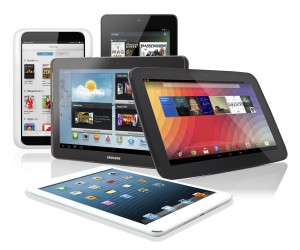Later tonight we will be reminded about the power of Apple and consumers’ apparent insatiable desire for new devices (consumers can pre-order the new iPhone). But this is not a post about the iPhone 6 and whether or not I should get the 6 or the 6 phablet…instead this is a reminder about the rise of mobility within supply chains.
Not too long ago, when Apple introduced the iPad it was viewed, rightfully, as a revolutionary consumer device. A device that would threaten the laptop market. Which it has. An unintended consequence was the iPad becoming a device that found its way onto the manufacturing floor, truck fleets, warehouses and other parts of the supply chain. Tablets gave workers on the floor a simple, mobile and connected interface with the necessary systems to allow the factory to run effectively and efficiently. Companies like GE’s Energ y Storage have been leveraging tablets on their factory floor to reduce the alerting time when outages occur. Rather than having floor managers monitor everything from a central control center, they now have that computation power and communications in a portable device. Truck fleets have adopted the usage of tablets to bring more intelligence and connectivity to their vehicles. Of course none of this is a bad thing for the likes of Apple, Google, Samsung or other players in the mobile device ecosystem.
y Storage have been leveraging tablets on their factory floor to reduce the alerting time when outages occur. Rather than having floor managers monitor everything from a central control center, they now have that computation power and communications in a portable device. Truck fleets have adopted the usage of tablets to bring more intelligence and connectivity to their vehicles. Of course none of this is a bad thing for the likes of Apple, Google, Samsung or other players in the mobile device ecosystem.
Tablets have also become a vital cog when it comes to how supply chain solution providers such as Llamasoft and JDA, offer their customers access to their offerings. Allowing for greater access to their software solutions – anywhere and anytime.
But is the world of mobility limited to tablets and smart phones? Absolutely not. On the contrary, the rise of wearables is the next wave of mobility in the supply chain. I remember walking the floor a few years ago at CSCMP’s annual event and seeing a number of companies displaying their devices – gloves, headware and other wearables – that would bring more efficiencies to supply chains. Many of these had to do with ensuring factory workers or those who pick and pack in the warehouse were as efficient as they could be. The problem is many of these devices were bulky and quite unwieldy. But similar to the adoption of consumer based tablets by companies, look for consumer wearbles to find their way onto the factory floor, warehouse and other environments. Let’s face it, consumer focused companies tend to make more aesthetically pleasing mobile devices, both in form and function.
For supply chain practitioners, do not hesitate to look to consumer device providers for your mobile needs. While there will be industry specific providers of devices, you might be able to find what you need from the likes of Apple or Samsung. Device manufacturers could consider these potential other uses, but in truth they should just focus on their primary targets – the consumer. Technology players must take into consideration what this growth in mobility for the supply chain means for them. Not only might they be asked to created apps for the devices, but how else can they take advantage of the increase in mobile and connected computing power?
New sleek gadgets like smart watches, clothing with senors, smarter tablets and phones are not only exploding in the consumer space but also for your supply chain. Interesting times we live in. Now I have to get back in line for my new iPhone.
Tagged: Manufacturing, Supply Chain, Tablets, Warehouse
![]()


